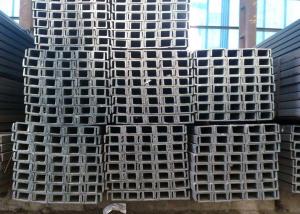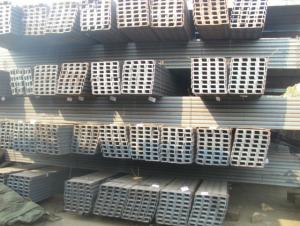High Quality JIS Steel Channel
- Loading Port:
- China Main Port
- Payment Terms:
- TT OR LC
- Min Order Qty:
- -
- Supply Capability:
- -
OKorder Service Pledge
OKorder Financial Service
You Might Also Like
Steel Channel
Standard: JIS
Material: SS400
Length: 6m, 12m
Size:
| Size (mm) | Mass (Kg/m) |
| 50*25*3.0 | 2.37 |
| 70*40*4.0 | 5.60 |
| 75*40*4.5 | 5.85 |
| 75*40*5.0 | 6.92 |
| 100*50*4.5 | 8.97 |
| 100*50*5.0 | 9.36 |
Package & Delivery of Steel Channel:
1.The hot rolled channel steel will be packed in bundle with steel wire at each end of every bundle and color marking in order to help the customer to recognize his goods more easily at sight.
2. And the hot rolled channel steel could be loaded into 20ft or 40ft container, or by bulk cargo.If the weight of each bundle reaches more than 3.5 mt, the loading by break bulk cargo should be choosed.When the weight of each bundle reaches less than 3mt, the loading by container should be choosed.
3.As for the transportaion from mill to loading port, the truck will be usually used. And the maximum quantity for each truck is 40mt.
4.All in all, we could do in accordance with customer's request.
Production Flow of JIS Channel:
1.The steel billet shall be heated in the high temperature furnace.
2. The heated steel billet shall be rolled five to nine times with the aim of shaping the general figure of steel u channel.
3. The rolled steel channel should be put onto the cooling bed to make the temperature low.
4. The JIS Channel should be straighted on the straightener.
5. The straighted steel u channel will be cut into meters by saw, as per customer's requirements.
6. At the last part of production, the channel steel must be tested in order to confirm that the finished products are completely free from crack, pore, slag, scab or fold on the surface.
*If you would like to get our price, please inform us the size, standard/material and quantity. Thank you very much for your attention.
- Q: How do steel channels contribute to structural stability?
- Steel channels contribute to structural stability in several ways. Firstly, they provide added strength and support to the structure. The shape of steel channels, with their wide base and narrow top, allows them to bear heavy loads and resist bending or twisting forces. This makes them ideal for use in beams, columns, and other structural members. Furthermore, steel channels can be used as reinforcement within concrete structures. When embedded in concrete, they enhance the overall strength and durability of the structure. Steel channels help distribute the load across a larger area, reducing stress concentrations and preventing localized failures. In addition, steel channels can be interconnected to form a framework, increasing the rigidity of the structure. By connecting steel channels in a network, they create a system that resists lateral forces such as wind or earthquakes. This helps maintain the stability of the structure and prevents it from collapsing or being damaged during extreme events. Moreover, steel channels are highly resistant to corrosion, which is essential for long-term structural stability. Unlike other materials, steel channels do not deteriorate easily when exposed to moisture, chemicals, or extreme temperatures. This durability ensures that the structural integrity of the building remains intact over time. Overall, steel channels play a vital role in enhancing the structural stability of buildings and other structures. Their strength, versatility, ability to reinforce concrete, and resistance to corrosion make them an indispensable component in construction.
- Q: Can steel channels be used in telecommunications infrastructure?
- Yes, steel channels can be used in telecommunications infrastructure. Steel channels provide structural support and are commonly used in the construction of telecom towers, antenna mounts, and equipment racks. They offer durability, strength, and corrosion resistance, making them suitable for supporting heavy equipment and withstanding outdoor conditions.
- Q: Can steel channels be used for creating support structures for HVAC systems?
- Yes, steel channels can be used for creating support structures for HVAC systems. Steel channels provide strength, stability, and durability required to support the weight and vibrations of HVAC components such as ductwork, pipes, and units. Their design flexibility and ability to withstand heavy loads make them a suitable choice for constructing reliable and long-lasting support structures for HVAC systems.
- Q: Can steel channels be used for stadium seating supports?
- Indeed, stadium seating supports can make use of steel channels. The strength, durability, and load-bearing capabilities of steel channels make them a frequent choice in construction and engineering ventures. Stadium seating structures necessitate adequate support and stability, both of which can be provided by steel channels. Furthermore, steel channels can be effortlessly fabricated and joined through welding to fashion tailor-made seating support systems capable of enduring substantial loads and guaranteeing the safety of spectators.
- Q: Can steel channels be used for supporting solar panels?
- Yes, steel channels can be used for supporting solar panels. Steel channels are commonly used in construction and engineering projects as they provide strength and stability. When properly designed and installed, steel channels can effectively support the weight of solar panels and provide the necessary structural support for their installation.
- Q: What are the maximum span lengths for steel channels?
- The maximum span lengths for steel channels depend on various factors such as the size and shape of the channel, the material grade, the load it is subjected to, and the desired deflection criteria. Generally, steel channels can have span lengths ranging from a few feet to several hundred feet. For smaller steel channels, such as C-shaped or U-shaped channels, the maximum span lengths typically range from 6 to 20 feet. These channels are commonly used for light structural applications, framing, or as support members in building construction. Larger steel channels, such as those used in heavy-duty industrial applications or as primary structural members, can have much larger span lengths. These channels are designed to withstand heavier loads and longer spans. In such cases, the maximum span lengths can extend to several hundred feet or even more, depending on the specific design requirements and engineering calculations. It is important to note that the maximum span lengths for steel channels should always be determined by a qualified structural engineer or designer who considers all the relevant factors and performs the necessary calculations to ensure the safety and structural integrity of the channel system. This ensures that the channel can effectively support the intended loads without excessive deflection or failure.
- Q: What's the width of the 22 channel wing?
- I am now with the project is channel 20A 22, channel steel has two specifications, 22a and 22b 22, said channel steel waist length 22cm
- Q: What are the typical applications of steel channels?
- Steel channels have various typical applications across multiple industries. They are commonly used in construction projects for framing, supporting structural loads, and creating framework for buildings, bridges, and infrastructure. Steel channels also find applications in manufacturing, where they are utilized as structural components in machinery, equipment, and vehicles. Additionally, they are frequently employed in the production of storage racks, shelving systems, and electrical enclosures. Overall, steel channels are versatile and widely used due to their strength, durability, and ability to provide structural support in a variety of applications.
- Q: How do you mark the types of steel such as channel, I-beam and so on in the document?
- Like the board, tube, and so on, right click on the Greek character mother with the keypad of the input method, and then choose.The thickness of the plate said.Phi means the diameter of the tube.H section steel, it is direct capital letters, H said in front of the good.A worker is a worker..Angle is digital symbols with small keyboard input method to select right angle of mathematical symbols.The slot is the keypad of the input method. Right click on the punctuation mark.By analogy.....
- Q: Are steel channels suitable for marine applications?
- Yes, steel channels are suitable for marine applications due to their high strength, durability, and corrosion resistance properties. They can withstand the harsh marine environment, including exposure to saltwater, making them ideal for various marine structures such as shipbuilding, offshore platforms, and marine infrastructure.
Send your message to us
High Quality JIS Steel Channel
- Loading Port:
- China Main Port
- Payment Terms:
- TT OR LC
- Min Order Qty:
- -
- Supply Capability:
- -
OKorder Service Pledge
OKorder Financial Service
Similar products
Hot products
Hot Searches
Related keywords




























